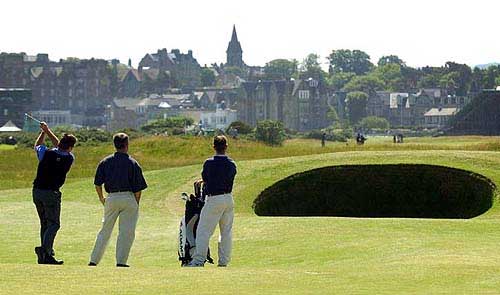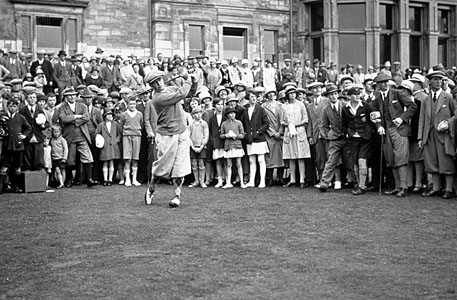The British Open – Making Golf History

The British Open is one of the world’s four major tournaments—with the Masters Tournament, the U.S. Open, and the Professional Golfers’ Association (PGA) Championship—and the oldest continually run championship in the sport.
The British Open is a unique event and is of great importance to professionals and amateur golfers alike, as well as to fans of golf.
The British Open has been held annually (with a few exceptions) on various courses in Scotland, England, and—on one occasion—Northern Ireland since 1860.
It’s not so easy to locate either, swallowed up in the sand hills and without any signs or gates at the club entrance and sheep grazing next to the road.
The first British Open was played on Oct. 17, 1860, at Prestwick Golf Club in Scotland. A field of eight professionals played three rounds of Prestwick’s 12-hole course in one day. Willie Park, Sr., won the inaugural tournament and was presented with the Challenge Belt, a silver-buckled leather belt that each champion was to keep until the following Open. The tournament was opened to amateurs in 1861
A Dr. Laidlaw Purves created St. George’s in the late 1880s out of frustration, not to mention necessity, when he couldn’t play Sundays at his own club, Royal Wimbledon in the southwest suburbs of London. Purves tramped along the Kent coast, finally climbed the tower of St. Clement’s Church in Sandwich, pointed out to some god-forsaken spot and fervently declared: “There I will build my course.”
In 1894, St. George’s became the first course in England to hold the Open. That was won by John Henry Taylor.
In the 1904 British Amateur, the champion was 37-year-old Walter Travis, an Australian-born American who was treated rather rudely, officials preventing him from practicing or lodging with other top players, burdening him with a cross-eyed caddy and not even permitting him to change into dry clothes between rounds on a rainy day.
“A reasonable number of fleas is good for a dog,” philosophized Travis, the first foreigner to win the Amateur. “It keeps the dog from forgetting he’s a dog.”
At St. George’s they didn’t forget. Once outside the clubhouse there was a sign, “No Dogs, No Women.”
Liberalization has crept in. Ladies now can play, although not by themselves, but they cannot be members. Somebody call Martha Burk.
Ian Fleming was a member for some 25 years. He used St. George’s as the site of the infamous match between James Bond and Goldfinger, only he thinly disguised it in the book as “St. Mark’s.” The film, however, was made at Stoke Poges, closer to London.
Recognizable in the novel are the classic short sixth hole, the Maiden, altered to the Virgin. And “the face of one of the tallest and deepest bunkers in the United Kingdom.”
That’s 240 yards from the tee on the fourth, rising 60 degrees and standing, or sliding, 30 feet high. It cannot be climbed, as one Reg Gladding verified in the 1979 British Amateur.
Going extra holes against a younger foe, the 54-year-old Gladding, confronted by a headwind, drove into the sand near the crest of the great bunker. He couldn’t risk entering from above, lest he cause a landslide, so Gladding crept up, a few inches at a time. He then addressed the ball, swung — and lost his balance and tumbled back down. Whereupon he immediately conceded the match.
It was at St. George’s where, in the 1922 Open, Walter Hagen protested a ban on professionals entering the clubhouse, hired a limo, parked it in front of the entrance and changed clothes and ate lunch within.
Victorious, Hagen sneered at the size of the winner’s check and gave it to his caddy. James Bond would have loved it. Source: Oakland Tribune



